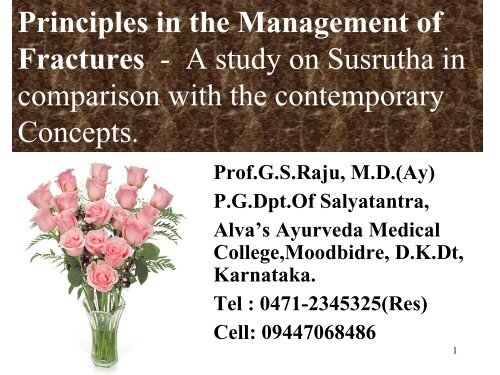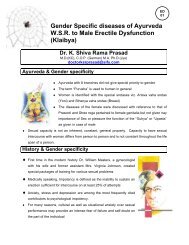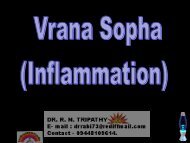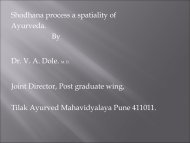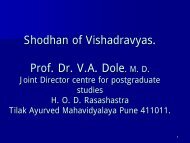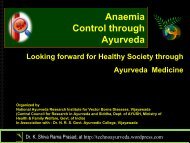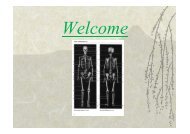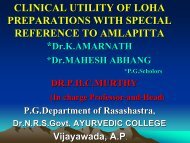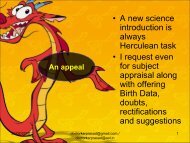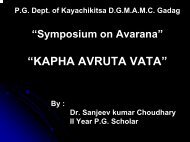read more - Techno Ayurveda
read more - Techno Ayurveda
read more - Techno Ayurveda
You also want an ePaper? Increase the reach of your titles
YUMPU automatically turns print PDFs into web optimized ePapers that Google loves.
Principles in the Management of<br />
Fractures - A study on Susrutha in<br />
comparison with the contemporary<br />
Concepts.<br />
Prof.G.S.Raju, M.D.(Ay)<br />
P.G.Dpt.Of Salyatantra,<br />
Alva’s <strong>Ayurveda</strong> Medical<br />
College,Moodbidre, D.K.Dt,<br />
Karnataka.<br />
Tel : 0471-2345325(Res)<br />
Cell: 09447068486<br />
5/11/2011 9:30:17 AM 1
5/11/2011 9:30:17 AM 2
5/11/2011 9:30:17 AM Prof.G.S.Raju.M.D.(Ay) 3
Definition<br />
“A fracture may be a complete or an<br />
incomplete break in the continuity of a bone, or<br />
a crack”. (J.C.Adams)<br />
Causes<br />
A relatively severe trauma is<br />
necessary to cause a fracture.<br />
The same clinical condition is referred to as<br />
“Bhagna” in the Ayurvedic texts.<br />
5/11/2011 9:30:17 AM Prof.G.S.Raju.M.D.(Ay) 4
Fracture is of different types according to<br />
the type and shape of the bone involved.<br />
‣Cartilages rarely break into fragments resulting<br />
in a typical fracture.They tend to bend causing<br />
greenstick type of fracture.<br />
‣Typical fracture occur in long bones.<br />
‣Fissures appear in flat bones.<br />
‣Irregular bones may crack and fall down.<br />
5/11/2011 9:30:17 AM Prof.G.S.Raju.M.D.(Ay) 5
Aetiology of fractures<br />
‣Fall<br />
‣Compression<br />
‣Blow with iron or wooden rods<br />
‣Strong pulling force<br />
‣Bite or attack by wild animals etc. are<br />
considered as predisposing factors of a<br />
fracture.<br />
5/11/2011 9:30:17 AM Prof.G.S.Raju.M.D.(Ay) 6
Where the violence is severe –<br />
‣ More than one bone is involved.<br />
‣ Fracture is seen at multiple sites of the same<br />
bone.<br />
‣ Both the shaft and joint is involved.<br />
In certain diseases,bones undergo fracture<br />
even in the absence of trauma,which is known as<br />
Pathological fracture.<br />
5/11/2011 9:30:17 AM Prof.G.S.Raju.M.D.(Ay) 7
Classification of fractures<br />
KANDA BHAGNA<br />
SANDHI BHAGNA (SANDHI MUKTA)<br />
Each of this is sub classified into different<br />
varieties. Criterion behind the terminology is the<br />
shape,displacement of fragments and the age<br />
factor.<br />
5/11/2011 9:30:17 AM Prof.G.S.Raju.M.D.(Ay) 8
Sub classification of KANDA BHAGNA<br />
Karkatakam Asthychallitam Vakram<br />
Asvakarnam<br />
Kandabhagnam Chinnam<br />
Choornitham<br />
Majjanugatham Patitham<br />
Pichitham Athipathitham Sputitham<br />
5/11/2011 9:30:17 AM Prof.G.S.Raju.M.D.(Ay) 9
Clinical features and differential diagnosis<br />
Karkatakam<br />
‣ Visheshatastu<br />
Sammodam ubhayatho<br />
asthimadhye bhagnam<br />
grandhi eva unnatham<br />
‣Fragments not<br />
displaced.<br />
‣Fracture confined<br />
to the shaft.<br />
‣Site of fracture is<br />
elevated.<br />
5/11/2011 9:30:17 AM Prof.G.S.Raju.M.D.(Ay) 10
Aswakarnam<br />
‣ Aswakarnavat<br />
udgatham<br />
Aswakarnam<br />
‣Pattern of<br />
fracture is oblique<br />
‣Fragments are<br />
elevated and/or<br />
displaced.<br />
5/11/2011 9:30:17 AM Prof.G.S.Raju.M.D.(Ay) 11
Choornitham<br />
‣ Sprushyamane<br />
sabdavat churnitham<br />
Avagachet<br />
‣ The number of<br />
fragments are<br />
multiple.<br />
‣ Multidirectional<br />
crepitus.<br />
5/11/2011 9:30:17 AM Prof.G.S.Raju.M.D.(Ay) 12
Pichitham<br />
‣Pichitham pruthutham gatham<br />
analpashopham<br />
‣Involvement of soft structures at the site<br />
of fracture.<br />
‣Separation from the remainder of the<br />
body<br />
‣Quick and extensive onset of swelling.<br />
5/11/2011 9:30:17 AM Prof.G.S.Raju.M.D.(Ay) 13
Asthichallitham<br />
‣ Parshvayorasthi<br />
heenodgatham<br />
Asthichallitham<br />
‣ Shape of fracture<br />
longitudinal.<br />
‣ Size of fragment is<br />
small.<br />
‣ Limited to the<br />
periphery of the bone.<br />
5/11/2011 9:30:17 AM Prof.G.S.Raju.M.D.(Ay) 14
Kandabhagnam<br />
‣ Vellathey<br />
prakampamanam<br />
kanda bhagnam.<br />
‣ Type of fracture is<br />
transverse.<br />
‣ Displacement of<br />
fragments present.<br />
‣ Tremors felt on<br />
attempted movements.<br />
5/11/2011 9:30:17 AM Prof.G.S.Raju.M.D.(Ay) 15
Majjanugatham<br />
‣ Asthi avayavo asthi<br />
madhyam<br />
anupravishya<br />
majjanam unahyathithi<br />
majjanugatham.<br />
‣ Fragments impacted.<br />
‣ Crepitus and abnormal<br />
mobility absent.<br />
5/11/2011 9:30:17 AM Prof.G.S.Raju.M.D.(Ay) 16
Atipatitham<br />
‣Asthi nissheshatah chinnam atipathitham<br />
‣These are usually caused by mechanical<br />
injuries resulting in complete loss of<br />
original shape,which is permanent.<br />
5/11/2011 9:30:17 AM Prof.G.S.Raju.M.D.(Ay) 17
‣ Abhugnam<br />
avimukthasthi<br />
Vakram<br />
‣ Absence of features of<br />
a typical fracture.<br />
‣ Shaft is bent and<br />
fracture incomplete.<br />
‣ Visible external<br />
deformity.<br />
5/11/2011 9:30:17 AM<br />
Prof.G.S.Raju.M.D.(Ay)<br />
18
Chinnabhagnam<br />
‣ Anyanthara<br />
parshwvashistam<br />
chinnam<br />
‣ Fracture is incomplete.<br />
‣ One side of the bone<br />
remain unbroken.<br />
5/11/2011 9:30:17 AM Prof.G.S.Raju.M.D.(Ay) 19
Patithabhagnam<br />
‣Patitham anu bahu vidaritham vedanavatcha<br />
‣Appearance of fissures over the flat bones.<br />
‣Number of fissures may be multiple and<br />
small in size.<br />
‣Severe pain.<br />
5/11/2011 9:30:17 AM Prof.G.S.Raju.M.D.(Ay) 20
Sputithabhagnam<br />
‣Sooka purnamivadmatham vipulam<br />
visputikrutham sputitham<br />
‣Severe pain.<br />
‣Multiple fracture/cracks at different sites.<br />
‣Small bones,teeth etc. are involved.<br />
5/11/2011 9:30:17 AM Prof.G.S.Raju.M.D.(Ay) 21
The different terminologies given to the<br />
types of fracture is based upon -<br />
‣ Change in the shape at the site of fracture.<br />
‣ Typical nature of displacement.<br />
‣ Number of fragments.<br />
‣ Type of the bone involved.<br />
‣ Size of the bone involved.<br />
‣ Extent of injury.<br />
‣ Age.<br />
5/11/2011 9:30:17 AM Prof.G.S.Raju.M.D.(Ay) 22
Different schools of fracture classification –<br />
Contemporary Orthopaedics<br />
A. Fractures caused solely by sudden<br />
injury.<br />
1. Direct fracture – which occur at the<br />
site of trauma. Eg. Fracture at the lower end<br />
of radius on fall with outstretched hands.<br />
2. Indirect fracture – which occur<br />
distal to the site of trauma. Eg. Fracture head<br />
of radius, fracture to clavicle etc. in fall with<br />
outstretched hands.<br />
5/11/2011 9:30:17 AM Prof.G.S.Raju.M.D.(Ay) 23
B. Fatigue fracture/Stress fracture - which<br />
occur not from a single violent injury but from<br />
often repeated stress. Eg. Fracture to<br />
metatarsals,Fibula,Tibia etc. This also is known<br />
as March fracture.<br />
C. Pathologic fracture - occur through bones<br />
which are al<strong>read</strong>y weak by diseases.Onset is<br />
spontaneous. Causes are-<br />
1.Local diseases of bones<br />
2.Congenital diseases<br />
3.Metastatic lesions<br />
5/11/2011 9:30:17 AM Prof.G.S.Raju.M.D.(Ay) 24
Local diseases are caused by –<br />
a) Infections d) Benign/Malignant tumors<br />
b) Syphilis e) Simple bone cyst etc.<br />
c) Bone atrophy<br />
Congenital diseases are -<br />
a) Osteogenesis imperfecta d) Infantile rickets<br />
b) Senile osteoporosis e) Multiple Myeloma<br />
c) Cushing’s syndrome<br />
Metastatic lesions are -<br />
a) Benign/malignant tumors b) Tuberculosis etc.<br />
5/11/2011 9:30:17 AM Prof.G.S.Raju.M.D.(Ay) 25
D. Classification based upon the wound<br />
accompanying the fracture –<br />
(a) Simple fracture<br />
OR<br />
Closed fracture<br />
(b) Compound fracture<br />
OR<br />
Open fracture<br />
5/11/2011 9:30:17 AM Prof.G.S.Raju.M.D.(Ay) 26
‣Simple or closed fracture is that - where there is no<br />
communication between the site of fracture and<br />
exterior of the body.<br />
‣Compound fracture or open fracture is that - when<br />
there is a direct communication established between<br />
the site of fracture and the exterior of the body.<br />
‣Such a parameter of classification is not seen in the<br />
Ayurvedic texts,with an exception to -<br />
Pichitha bhagnam which is classified into<br />
1.Savrana and<br />
2.Avrana bhagna.<br />
5/11/2011 9:30:17 AM Prof.G.S.Raju.M.D.(Ay) 27
E. Another method in the contemporary works is<br />
indicative of the causative injury/type of bone<br />
involved/type of displacement of fragments.<br />
* Greenstick fracture * Compression fracture<br />
* Infraction * Oblique fracture<br />
* Avulsion fracture * Spiral fracture<br />
* Epiphyseal separation * Transverse fracture<br />
* Comminuted fracture * Pathologic fracture<br />
* Intra Articular fracture<br />
5/11/2011 9:30:17 AM Prof.G.S.Raju.M.D.(Ay) 28
Pattern of fracture<br />
Generally used terms are –<br />
* Transverse fracture * Oblique fracture<br />
* Spiral fracture * Comminuted fracture<br />
* Compression fracture * Greenstick fracture<br />
* Impact fracture<br />
Pattern of fracture denote -<br />
* The causative violence<br />
* Easiest method of reduction<br />
5/11/2011 9:30:17 AM Prof.G.S.Raju.M.D.(Ay) 29<br />
* Stability of fragments
Comparison<br />
Kanda bhagnam & Transverse fracture<br />
Karkatakam<br />
Aswakarnam Oblique fracture<br />
Choornitham<br />
Comminuted fracture<br />
Vakram Greenstick fracture<br />
Majjanugatham Impact fracture<br />
5/11/2011 9:30:17 AM Prof.G.S.Raju.M.D.(Ay) 30
Clinical features of a fracture<br />
‣ Swayathu Bahulyam (Diffuse swelling at the site of<br />
fracture)<br />
‣ Spandana Vivarthana Sparshrsahisnutwam (Loss of<br />
movement of the part and tenderness)<br />
‣ Avapeedyamane Sabda (Crepitus)<br />
‣ Srashtangatha (Flaccidity of muscle)<br />
‣ Vividha Vedana Pradurbhava (Pain of varying nature)<br />
‣ Sarvasthasu na sarmalabha (No relief in pain at any<br />
position and overall restlessness)<br />
5/11/2011 9:30:17 AM Prof.G.S.Raju.M.D.(Ay) 31
Due to the force of violence ----<br />
‣ Smooth tissues around the bone are injured <br />
exudation of fluid Oedema.<br />
‣ Extra vasation of blood Oedema.<br />
‣ Oedema is increased in direct fracture.<br />
‣ Closed fracture is aseptic.<br />
‣ Pressure exerted by fragments upon nerve ends <br />
Pain.<br />
‣ Severe pain/injury to nerves Loss of movement.<br />
‣ Grating of fragments Crepitus.<br />
‣ Loss of continuity of bone Loss of integrity.<br />
5/11/2011 9:30:17 AM Prof.G.S.Raju.M.D.(Ay) 32
Symptoms vary from bone to bone, still general<br />
features are-<br />
* Swelling * Continuous pain<br />
* Loss of function of the affected part.<br />
Signs of fracture<br />
* Visible/palpable deformity * Local swelling<br />
* Visible bruising/Echymosis * Local Tenderness<br />
* Marked impairment of function<br />
Unmistakable evidences are….<br />
* Abnormal mobility between fragments<br />
*<br />
5/11/2011<br />
Crepitus<br />
9:30:17 AMon attempted<br />
Prof.G.S.Raju.M.D.(Ay)<br />
movements. (J.C.Adams)<br />
33
Diagnosis of fracture:<br />
Local Symptoms<br />
General symptoms<br />
Local symptoms are :<br />
* Pain * Deformity<br />
* Swelling * Crepitus<br />
* Loss of function * Difference in length<br />
General symptoms are :<br />
* Fever * Shock * Delerium<br />
* Fatembolism * Hemorrhage * Necrosis<br />
5/11/2011 9:30:17 AM Prof.G.S.Raju.M.D.(Ay) 34
Presence of a fracture can almost be inferred from :<br />
* History presented by the patient<br />
* The clinical symptoms<br />
But radiographs are necessary to establish the excact<br />
nature of the fracture.<br />
Some fractures may be overlooked- Eg:<br />
* Pathological fracture * Greenstick fracture<br />
* Impact fracture * Fatigue fracture<br />
* Fracture of small bones.<br />
5/11/2011 9:30:17 AM Prof.G.S.Raju.M.D.(Ay) 35
Radiographic Examination.<br />
• Clinical evidence of a fracture should always be<br />
confirmed by radiographic examination,whereby<br />
no fracture is overlooked.<br />
• Standard method is to have two projections in<br />
planes- Usually Antero- Posterior and Lateral.<br />
• The film should include sufficient length of the<br />
bone above and below the site of fracture.<br />
5/11/2011 9:30:17 AM Prof.G.S.Raju.M.D.(Ay) 36
Prognosis of fracture is poor in ----<br />
* Choornitha Bhagnam<br />
* Atipatitha Bhagnam<br />
* Majjanugatha Bhagnam<br />
* Fracture in - (a) Extremely emaciated<br />
patients (b) Elderly individuals (c) Infants and<br />
children (d) Fracture in persons al<strong>read</strong>y weak by<br />
injuries (e) Patients with respiratory disorders.<br />
5/11/2011 9:30:17 AM Prof.G.S.Raju.M.D.(Ay) 37
Fracture to certain bones and joints are also with poor<br />
results. They are –<br />
* Fracture to flat bones of the pelvis and cranial<br />
vault.<br />
* Crush fracture of pelvis.<br />
* Fracture of suture joints.<br />
* Fracture to sternum,spine,temporal bone etc.<br />
* Bones and joints with congenital anomaly.<br />
* Fracture in which displacement of fragments<br />
relapse.<br />
Time span required for healing of fractures is also<br />
described by Susrutha in detail.<br />
5/11/2011 9:30:17 AM Prof.G.S.Raju.M.D.(Ay) 38
Management of Fractures.<br />
When the diagnosis of fracture has been<br />
made,additional examination is to be done to<br />
determine the following -<br />
‣ Is there a wound communicating with the<br />
fracture<br />
‣ Is there any impairment of circulation<br />
‣ Is there any evidence of nerve injury<br />
‣ Is there any evidence of visceral injury<br />
5/11/2011 9:30:17 AM Prof.G.S.Raju.M.D.(Ay) 39
The X-ray film must be well examined to ascertain –<br />
‣ Is the fracture an ordinary traumatic<br />
fracture/Fatigue fracture/Pathologic fracture <br />
‣ Are the fragments displaced <br />
‣ Are the fragments in satisfactory alignment <br />
‣ Is the fracture a recent one <br />
‣ Any evidence of callus tissue <br />
‣Is there any injury to the neighboring bone or joint <br />
‣ Is there any features suggesting degeneration <br />
5/11/2011 9:30:17 AM Prof.G.S.Raju.M.D.(Ay) 40
Before any definitive treatment, sufficient care is to<br />
be directed to ----<br />
‣First aid treatment.<br />
‣Measures to control bleeding (if present).<br />
‣Measures to overcome shock.<br />
‣Special care in transportation for patients with spinal<br />
injury.<br />
‣Traction to the fractured limb while moving the<br />
patient (Lower limb).<br />
‣Around the chest bandage or a sling for upper limb<br />
injuries.<br />
‣Maintenance of a clear air way and pulmonary<br />
ventilation.<br />
5/11/2011 9:30:17 AM Prof.G.S.Raju.M.D.(Ay) 41
Definitive treatment.<br />
Objectives:-<br />
* Approximation of bone ends.<br />
* Realignment of fragments as far as possible.<br />
* Immobilization till healing.<br />
In other words, the principles can be summarized as<br />
REDUCTION<br />
IMMOBILIZATION<br />
<br />
PRESERVATION OF FUNCTION<br />
5/11/2011 9:30:17 AM Prof.G.S.Raju.M.D.(Ay) 42
Reduction.<br />
* Application of logical sequence of forces to<br />
reverse the deformity caused by the fracture is called<br />
Reduction.<br />
* In many fractures, reduction is<br />
unnecessary. Eg:Fracture to clavicle,spine,small bones<br />
etc.<br />
* If reduction is decided, it is carried out as –<br />
‣Closed manipulative reduction.<br />
‣By mechanical traction.<br />
‣Operative 5/11/2011 9:30:17 AM reduction Prof.G.S.Raju.M.D.(Ay) with or without internal fixation. 43
Closed manipulative reduction is the initial<br />
standard method in most of the fractures.<br />
Procedure:-<br />
‣ Grasp the fragments through soft tissue.<br />
‣ Disimpact the fragments if necessary.<br />
‣ Adjust the fragments as nearly as possible to the<br />
original shape.<br />
‣ When the epiphysis is involved, the reduction<br />
should be excellent.<br />
‣ Intra articular fracture also require excellent<br />
reduction.<br />
5/11/2011 9:30:17 AM Prof.G.S.Raju.M.D.(Ay) 44
Immobilization.<br />
It also is not necessary in all fractures.<br />
Eg:Fracture clavicle.<br />
Immobilization helps in –<br />
‣ Prevention of displacement of fragments.<br />
‣ Prevention of angulations.<br />
‣ Prevention of excess movements.<br />
‣ Relief from pain and swelling.<br />
‣ Retaining sufficient contact between fragments<br />
which help in healing.<br />
5/11/2011 9:30:17 AM Prof.G.S.Raju.M.D.(Ay) 45
Immobilization is carried out by:-<br />
<br />
<br />
<br />
<br />
P.O.P. Cast<br />
External splints.<br />
Continuous traction.<br />
Internal fixation.<br />
* Immobilization should include the joints distal and<br />
proximal to the site of fracture.<br />
* Care to prevent possible ischaemia distal to the site<br />
of fracture.<br />
* Internal fixation is decided to hold the fragments in<br />
5/11/2011 9:30:17 AM Prof.G.S.Raju.M.D.(Ay) 46<br />
acceptable position and to secure earlier mobility.
Open or compound fracture require ----<br />
‣ Urgent surgical attention.<br />
‣ Cautiously deal with the risk of infection.<br />
‣ Wound should be well cleaned.<br />
‣ Foreign bodies if present be removed.<br />
‣ Actual treatment of fracture to start only after<br />
the wound has been properly dealt with.<br />
5/11/2011 9:30:17 AM Prof.G.S.Raju.M.D.(Ay) 47
Rehabilitation – is one of the very important<br />
principle in fracture treatment.<br />
Objective - is to use the limb freely and as early<br />
as possible.<br />
Specific exercises and other arrangements should<br />
be advised. These methods are collectively called<br />
Physiotherapy, which has developed into a full<br />
fledged complementary branch.<br />
Susrutha very clearly describes the same principles<br />
along with fracture management.<br />
5/11/2011 9:30:17 AM Prof.G.S.Raju.M.D.(Ay) 48
Management of fracture and dislocations –<br />
an Ayurvedic perspective<br />
Principles:<br />
‣ Asthy Sthapana (Fixation by reduction)<br />
‣ Immobilization of the involved part.<br />
‣ Methods of mobility exercises.<br />
‣ Application of suitable medicines both internal<br />
and external.<br />
‣ Special dietary schedule with rich nutritive<br />
content.<br />
‣ Manipulative reduction is advised in fractures<br />
with displaced fragments.<br />
5/11/2011 9:30:17 AM Prof.G.S.Raju.M.D.(Ay) 49
Methods of manipulation.<br />
‣ Lifting of fragments which have been depressed.<br />
‣ Fragments which protrude have also to be<br />
depressed.<br />
‣ Avulsed fragments have to be pulled back into<br />
position.<br />
‣ Fragments which have gone down have to be<br />
lifted upwards.<br />
Summarizing the methods, he names the technique as<br />
* Anchana * Unnamana<br />
* Peedana * Samkshepa<br />
5/11/2011 9:30:17 AM<br />
* Bandhana<br />
Prof.G.S.Raju.M.D.(Ay) 50
Types of bandages.<br />
* Kosa * Swasthika * Pratholi<br />
* Cheenam * Damam * Anuvellitham<br />
* Khatva * Vibandha * Sthagika<br />
* Vithanam * Utsangi * Gophanam<br />
* Yamakam * Mandalam * Panchangi<br />
Proper application of splints and bandage help to<br />
prevent -<br />
* Mal union * Non union * Necrosis<br />
Depending upon the extent of pressure, they are<br />
brought under three main heads –<br />
* Gada * Sama * Sidhila<br />
5/11/2011 9:30:17 AM Prof.G.S.Raju.M.D.(Ay) 51
Removal and reapplication of bandages at regular<br />
intervals is a unique feature of Ayurvedic fracture<br />
management.<br />
Rebandaging is advised once in –<br />
* 3 days * 7 days * 5 days<br />
depending upon the climatic variations.<br />
Stages of healing….<br />
‣ Stage of Haematoma<br />
‣ Stage of Sub periosteal and Endosteal cellular<br />
proliferation.<br />
‣ Stage of Callus<br />
‣ Stage of consolidation<br />
‣ Stage of remodeling<br />
5/11/2011 9:30:17 AM Prof.G.S.Raju.M.D.(Ay) 52
Factors influencing healing.<br />
* Proper nutrition * Proteins and amino acids<br />
* Calcium * Vitamins A,C & D<br />
* Hormones (Parathormone, Calcitonin,sex hormones)<br />
Local factors.<br />
* Inadequate apposition *Inadequate immobilization<br />
* Inadequate circulation etc. delay healing.<br />
Complications related to the fracture itself –<br />
*Infection * Delayed union * Non union<br />
* Avascular necrosis * Mal union * Shortening.<br />
5/11/2011 9:30:17 AM Prof.G.S.Raju.M.D.(Ay) 53
Complications related to associated injuries –<br />
‣ Injury to major blood vessels.<br />
‣ Injury to nerves.<br />
‣ Injury to viscera.<br />
‣ Injury to tendons.<br />
‣ Injury and post traumatic affections of joints.<br />
‣ Fatembolism.<br />
Failure in union is uncommon in children except<br />
fracture of Capitulam of Humerus. Supra condylar<br />
fracture of Humerus has to be very carefully dealt<br />
with. Fractures involving epiphysis should also be<br />
dealt with cautiously.<br />
5/11/2011 9:30:17 AM Prof.G.S.Raju.M.D.(Ay) 54
Symptoms of proper union.<br />
‣ Site of fracture is free from swelling.<br />
‣ Site of fracture is not hard on palpation.<br />
‣ Absence of deformities.<br />
‣ Absence of protrusion and displacements.<br />
‣ Resumption of all normal functions.<br />
‣ Subsidence of pain.<br />
5/11/2011 9:30:17 AM Prof.G.S.Raju.M.D.(Ay) 55
Some rare cases<br />
5/11/2011 9:30:17 AM Prof.G.S.Raju.M.D.(Ay) 56
5/11/2011 9:30:17 AM Prof.G.S.Raju.M.D.(Ay) 57
5/11/2011 9:30:17 AM Prof.G.S.Raju.M.D.(Ay) 58
5/11/2011 9:30:17 AM Prof.G.S.Raju.M.D.(Ay) 59
5/11/2011 9:30:17 AM Prof.G.S.Raju.M.D.(Ay) 60
5/11/2011 9:30:17 AM Prof.G.S.Raju.M.D.(Ay) 61
5/11/2011 9:30:17 AM Prof.G.S.Raju.M.D.(Ay) 62
5/11/2011 9:30:17 AM Prof.G.S.Raju.M.D.(Ay) 63
Prof.G.S.Raju.M.D.(Ay)<br />
Kalathil House<br />
31-B- Durga Nagar<br />
Karamana,Trivandrum-2<br />
Tel: 0471-2345325<br />
Cell: 09447068486<br />
5/11/2011 9:30:17 AM 64


